In the Middle Ages a chapel had been erected on this site in honor of Our Lady, Star of the Sea. This maritime association with the Virgin was important since ships were anchored nearby. Prince Henry the Navigator ordered that additions be built to the small chapel and then renamed it Santa Maria de Belém. Even though it was in a state of disrepair, Vasco da Gama had worshiped in this chapel before his fleet's departure in 1497 for what would eventuate in the discovery of the sea route to India. Thus the chapel in this area had always had close connections with seafaring life. The present monastery was commissioned by King Manuel I (who reigned 1495-1521) and work began on it in 1502 with the construction taking almost one hundred years. Manuel conceived of it as a token of the country’s gratitude to Vasco da Gama.
This sixteenth century monastery is a Portuguese version of late Gothic style, named "Manueline" in honor of the founder of the monastery, King Manuel I. According to Paulo Pereira who cites Francisco Adolfo Varnhagen, this style is defined by a number of characteristics, some of which are the prevalence of semicircular and depressed arches (rather than pointed arches), polystile or multiple pillars, elaborate decoration on the pillars, lack of symmetry, use of floral and royal motifs, absence of straight moldings, and surfaces with niches, statues, and canopies (45). He cites as erroneous the description that claims that nautical motifs were a defining characteristic of this style. The first design of the monastery was the work of the architect Diogo de Boytac (c. 1460-1528), although other master builders and craftsmen also left their marks on the building, namely Juan of Castile (c. 1475-1552), Diogo of Torralva (1500-1566) and Jerome of Rouen (1530-1601).
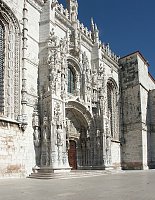
|
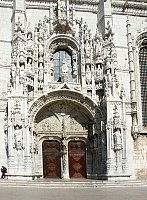
|
South Portal by Juan of Castile, 1517-18The portal extends upward for two stories and is framed by two buttresses. The door jambs--at the lowest level--depict the twelve Apostles. |
| |
|
Our Lady of the Three Kings (or Santa Maria de Belém)The infant Jesus holds a vessel containing the gifts of the Magi. Female saints under canopies are at the level of Mary and the Doctors and Fathers of the Church are above them. At the very top is the Archangel Michael. |
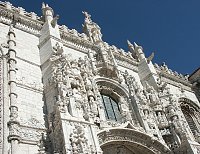
|
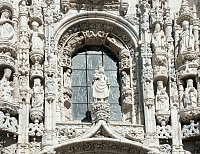
|
| |
|
Tympana, South Portal, with scenes from the life of Saint Jerome above the doorway and the Portuguese coat of arms in the arch between the two tympana; underneath the tympana on the door frame medallions representing possibly Queen Maria and King ManuelThe scene on the left depicts Jerome in Cardinal's robes pulling a thorn from the paw of the lion, which thereafter became his devoted friend--adventures recounted in the Golden Legend. The scene on the right depicts the penitential saint in the desert. He holds a large stone with which he may beat his breast and kneels before a crucifix.
|
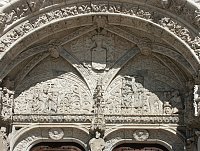
|
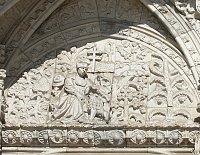
|
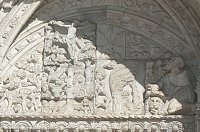
|
| |
|
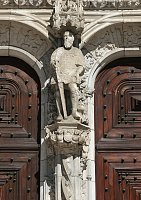
|

|
A secular figure: Henry the Navigator, trumeau, South PortalThis restored statue may have originally held a sword aloft. The statue commemorates Manuel's ancestor, and Manuel was in fact Prince Henry's adopted grandson. Both administered the Order of Christ (Pereiera 57). |
| |
|
Three of the Twelve Apostles, on the left hand side jambs of the South Portal; the enormous window with elaborate carved frame
|
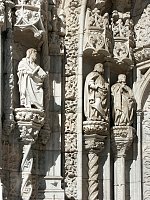
|
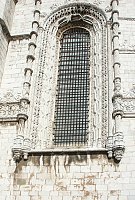
|
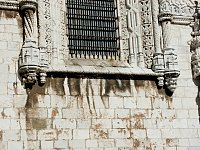
|
| |
|
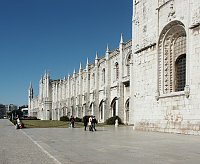
|
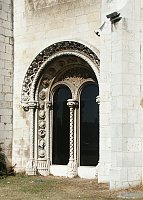
|
The long southern facade set parallel to the riverWith a horizontal emphasis, the extensive facade is more than 300 meters long and made of pedra lioz, a faux marble (or white limestone) from local quarries. |


 Click here to return to index of art historical sites.
Click here to return to index of art historical sites.
 Click here to return to index of artists and architects.
Click here to return to index of artists and architects.
 Click here to return to chronological index.
Click here to return to chronological index.
 Click here to see the home page of Bluffton University.
Click here to see the home page of Bluffton University.
